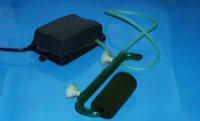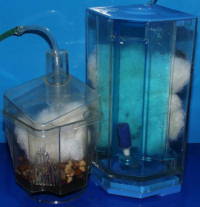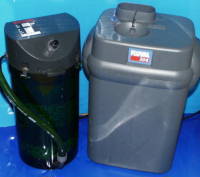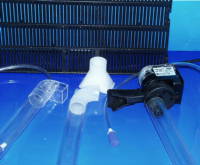|
|
Filtration
Filtration can be considered as three major types: mechanical, biological and adsorptive/chemical.
Mechanical filtration is necessary to remove particles from the water to keep the water sparkling clear and to maximise the efficiency of subsequent biological or adsorptive filtration.
Biological filtration is essential to ensure the breakdown of waste products in the aquarium by 'friendly' bacteria. This occurs most efficiently in highly porous media such as sponge and specific bio-media such as ceramic tubes and sintered glass. This media should only be lightly rinsed in aquarium water (not tap water) to maintain the bacterial colonies which establish.
Adsorptive media selectively remove various substances from the water. Examples include activated carbon which removes toxins, medications, dyes, etc. and specific resins which remove ammonia, nitrate, phosphate, etc. These products are also often referred to as chemical media, although some would reserve this term for media which chemically modify aquarium water in other ways, such as peat which can acidify water by adding humic and tannic acids.
TYPES OF FILTER
|
Sponge filter
This is the most basic type of filter which consists simply of a sponge through which water
is drawn by rising air bubbles from an air pump. The sponge acts mechanically, and once matured,
biologically. These filters are ideal for small breeding and rearing tanks where a power filter
might suck fry into the filter inlet.
|
 |
|
Box filter
These are also air powered and come in a number of sizes to suit small to medium sized tanks.
The airflow draws water through the chamber of the filter which can be filled with the desired
media. This type of filter can be moved between tanks to provide additional mechanical filtration
using filter wool for example, or for adsorption of specific waste products using carbon or
specialised adsorbent resins.
|
 |
|
Internal power filter
This type of filter utilises an electrically powered centrifugal pump to draw water through the
filter material, normally sponge. They may have additional chambers for adsorptive media or
additional mechanical/biological media. They generally create a more powerful circulation than
air-powered filters. They are ideal for aquariums in the 2ft - 4ft size range, and are useful in
combination with external canister filters for large aquariums. They also provide useful extra
mechanical filtration when used in conjunction with undergravel filtration.
|
|
HOT/HOB filters
Hang-On-Tank or Hang-On-Back filters are popular in the US and other regions, and are similar to internal
power filters in terms of design principle and the size of aquarium that they are suitable for. Some use
disposable cartridge systems to facilitate easier maintenance. The cartridge system may not cater for
bio-filtration adequately, so models which include a sponge filter or an add-on like the BIO-Wheel are
preferable.
The BIO-Wheel is an efficient bio-filter which can be added to different filtration systems and functions
like a wet-dry filter (see below).
|
|
External canister filter
These work on the same principle as internal power filters, but are positioned outside the tank
and draw water into the filter through an inlet tube and return the water via another tube, which
can be fitted with a spray bar to increase aeration. They avoid the need for an unsightly filter
inside the tank, but this has the disadvantage that they require priming before use, although
modern designs now incorporate self-priming devices. The media capacity is much larger than
internal filters and they are therefore suitable for much larger tanks. They normally incorporate
areas for several media types so the media can be tailored to suit the requirements of individual
tanks. They are a good choice for larger planted tanks.
|
 |
|
Undergravel filters (UGF)
Undergravel filters work by drawing water from the tank down through the gravel substrate, which
acts as a mechanical and biological filtration media. This gives a huge surface area for
filtration. The gravel does need to be 'vacuumed' occasionally however, to prevent the build-up
of excess dirt in the gravel and beneath the filter plates.
|
|
The water is drawn through the
undergravel filter plates and into uplift tubes by an airpump or powerhead. Powerheads will give
a more rapid turnover and stronger circulation. Reverse-flow undergravel filtration (RUGF) works
by drawing water from the aquarium, through a prefilter of some sort (which could be anything
from a simple sponge to an external canister filter), and forcing it DOWN the uplift tubes and
up through the gravel. This avoids the problem of excessive debris building up in the gravel and
beneath the filter plates.
|
 |
|
Sump filters
Sump filters are large (often home-made) outside filters placed below the main tank. They may
consist of a smaller aquarium tank or other container filled with filter media. Heaters may also
be placed in this sump tank to keep them out of the main tank. They may be quite complex in design
and are especially useful for marine tanks because additional equipment, such as protein skimmers,
can be placed in them. They also have the advantage of increasing the overall volume of the system.
|
|
|
Trickle (wet/dry) filters
These may also be home-made, but are also available commercially. They are very efficient at
biological filtration and work on a principle similar to many sewage treatment plants. Water is
sprayed over the surface of the media, often in several layers, so that a 'pulse' of highly
oxygenated water is delivered to the media. Other wet-dry systems are incorporated into canister
filter type designs.
|
|
|
Fluidised bed filters
These are specialised biological filters which rely on a constantly moving bed of sand as the
filter medium. This provides a huge surface area for bacterial colonisation and the constant
rubbing together of sand grains ensures that loosely attached debris and dying bacterial
colonies are removed. They act only as biological filters and require a mechanical prefilter,
such as a powerhead cartridge, or an internal or external powerfilter.
|
 |
|
Diatom filters
These are often used for short term mechanical filtration to improve water quality. The media used
clogs quickly, trapping smaller and smaller particles. They need to be cleaned after each use but
are very useful for giving water a quick polish.
|
|
[Home]
[Article Library]
[Fish Index]
[Tank Setups]
[Forum]
[Site Map]
|
|
|







